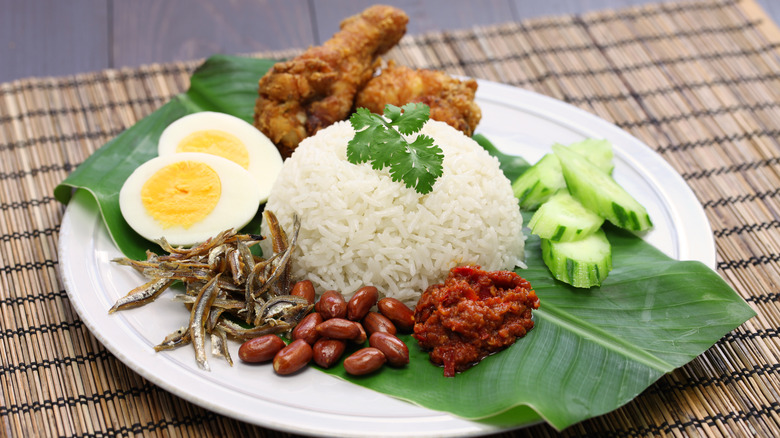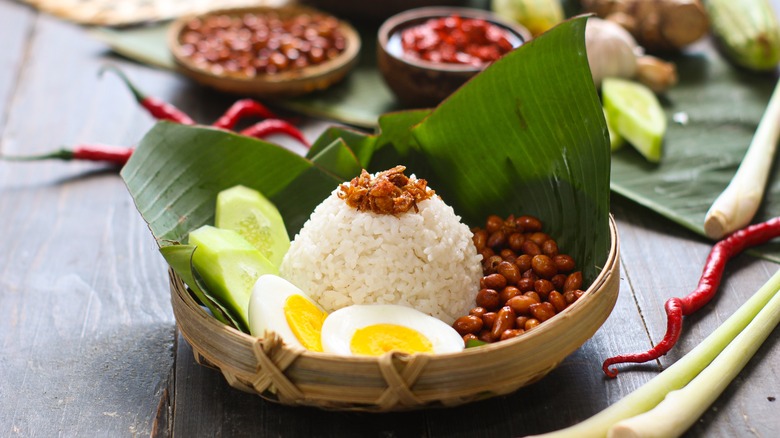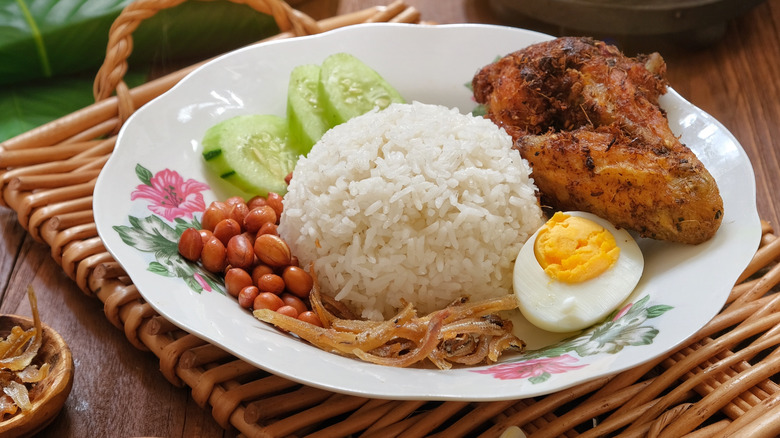Malaysia's National Dish, Nasi Lemak, Makes For A Hearty Breakfast
In Malaysia, breakfast food is a medley of vibrant flavors, textures, and cuisines. It's best enjoyed in kopitiams — vibrant coffee houses serving sweet treats like kaya butter toast, caffeinating beverages, and, most iconically, nasi lemak. The national dish of Malaysia, this delicious food consists of fragrant coconut rice topped with a medley of fresh and prepared ingredients, such as anchovies, sambal, cucumbers and more. Wrapped or plated on a banana leaf, it's the country's go-to breakfast, available ubiquitously at an accessible price throughout the day.
A testament to the nation's incredibly storied, multi-ethnic cuisine, nasi lemak has risen in popularity, especially abroad. Chefs are offering new, updated takes, and traditional establishments still provide dependable interpretations. And best of all, it's wondrously malleable, easily sopping up a delicious beef rendang or piece of fried chicken. After an initial sampling, the buzz is easy to understand — it's a national favorite for good reason.
Background of nasi lemak
Although also enjoyed in Indonesia and Singapore, Nasi lemak originated in the western part of the Malay peninsula. It's believed the dish emerged near the city of Malacca, a historic trade hub and culinary hotspot, where many food fusions took place. In the region, both coconuts and anchovies were readily accessible, creating the foundation of the dish.
Nasi lemak was first noted in print in 1909. However, the preparation had likely already spread to other Malay communities. Locals adapted the dish with distinct ingredients and styles and it slowly became a national classic. By the 1970s, it was established as a ubiquitous street food, sold on the street, door-to-door, and at food halls. Today, it can still be found in such settings, as well as at chains like McDonald's, and in creative riffs that can encompass desserts, burgers, and more. Such ubiquity makes it a proud rendition of Malaysian cuisine that's often consumed with family and friends.
What's in nasi lemak?
Nasi Lemak's most fundamental component is the rice; prepared in pandan leaf alongside a generous amount of coconut milk. Such a technique lends the dish its name — rich rice. Traditional accompaniments include the anchovies fried to crispy perfection, sliced cucumber, boiled eggs, and nuts — especially peanuts. And perhaps most importantly, it's garnished with a unique rendition of spicy sambal. In Singapore, the chili paste is prepared to a sweeter, less sweat-inducing state.
From such a classic backbone, nasi lemak variations are abundant. Many eateries serve with a small serving of a signature dish, like a piece of fried chicken or a spoonful of sambal sotong. A wave of modern chefs have reinterpreted the food in innovative directions, making it a burger, turning it into a salad, or even a cheesecake dessert. Recalling familiar flavors, a serving of nasi lemak in Malaysia hits a comforting, always flavorful, and delicious note.


